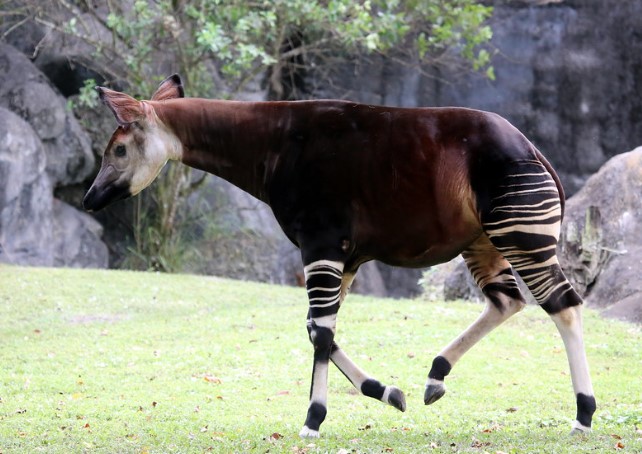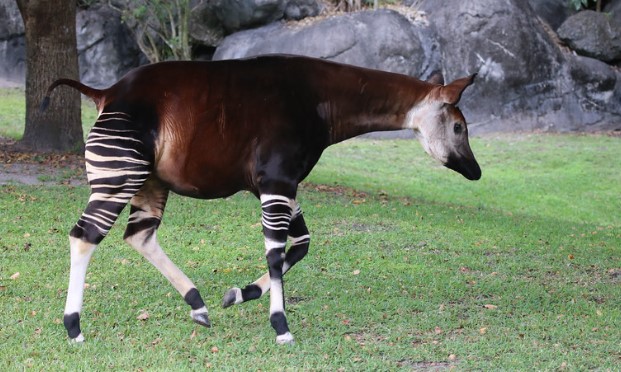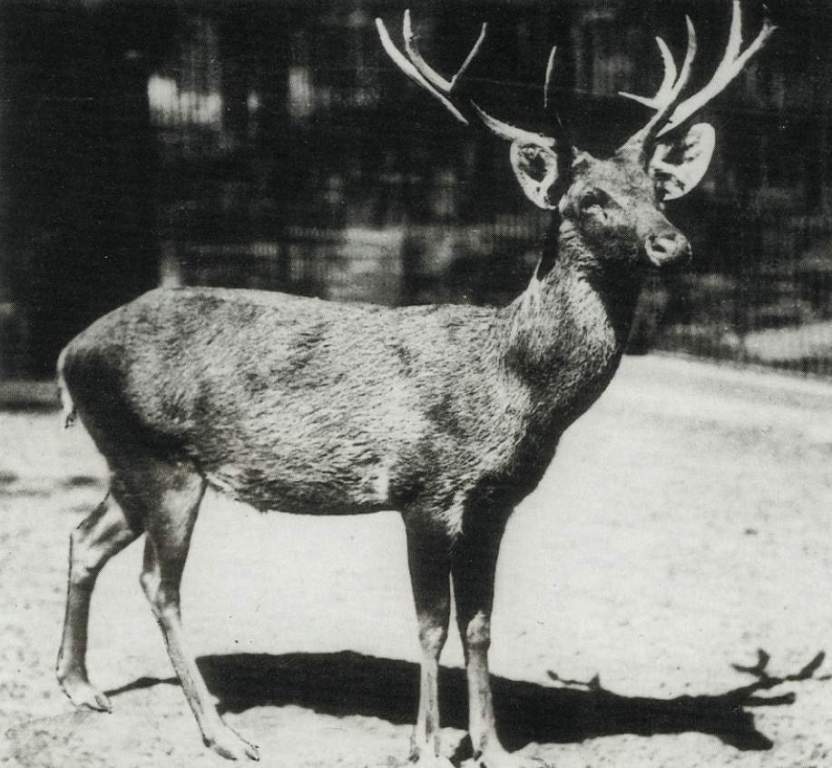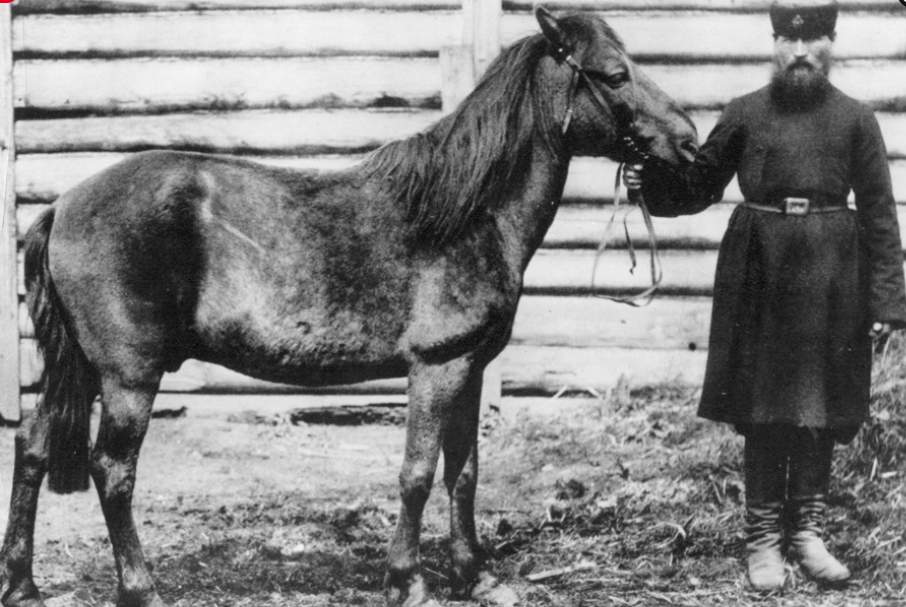The Okapi, also known as the Forest Giraffe, Congolese Giraffe, and Zebra Giraffe, is a unique species of artiodactyl mammal that is found only in the northeast Democratic Republic of the Congo in central Africa. It is the only member of its genus, Okapia. Although its striped markings are similar to zebras, it is closely related to the giraffe and they are the only surviving members of the family Giraffidae.
The Okapi is approximately 4 ft 11 in tall at the shoulder and has a typical body length of 8 ft 2 in. Its weight ranges from 440 to 770 lbs. Its distinctive features include a long neck, large, flexible ears, and a coat that is chocolate to reddish brown with white horizontal stripes and rings on the legs and ankles. Males have short, horn-like protuberances on their heads called ossicones, which are less than 5.9 in length, while females have hair whorls but lack ossicones.
Okapis are active during the day but may be active for a few hours in the dark. They are solitary creatures, coming together only to breed. They feed on a variety of vegetation, including tree leaves and buds, grasses, ferns, fruits, and fungi. Their breeding cycle is not dependent on the season and in captivity, their estrus cycle occurs every 15 days. The gestational period is approximately 440 to 450 days and usually results in the birth of a single calf. Juveniles are kept hidden and nursing is infrequent. They start eating solid food at three months old and are fully weaned at six months.
Forest Giraffe are found in the canopy forests at altitudes between 1,600 and 4,900 ft. The International Union for the Conservation of Nature and Natural Resources classifies them as endangered due to habitat loss from logging and human settlement, as well as illegal mining and hunting for bushmeat and skin. The Okapi Conservation Project was established in 1987 to protect the species and its populations.

The Okapi, was not well known to the Western world until the 20th century. Despite this, there is evidence to suggest that the Okapi may have been depicted as far back as the 5th century BCE on the Apadana at Persepolis, as a gift from Ethiopia to the Achaemenid kingdom. European explorers in Africa had heard tales of an animal referred to as the “African unicorn” and this was brought to the attention of the Western world through press reports on Henry Morton Stanley’s journeys in 1887. In his travelogue of exploring the Congo, Stanley mentioned a local animal known as the “atti” that was later identified as the Okapi.
When Sir Harry Johnston, the British special commissioner in Uganda, encountered Pygmy inhabitants of the Congo being abducted for exhibition, he rescued them and learned more about the elusive animal. Despite not seeing the Okapi himself, Johnston was able to obtain a skull and pieces of striped skin, which allowed for the species to be classified as a relative of the giraffe in 1901 and named Okapia johnstoni. In 1901, a painting of the Okapi was presented to the Zoological Society of London, causing much confusion regarding its taxonomical status. Despite various suggestions, it was ultimately placed in its own genus and sister of Giraffa through cladistic analysis in 1986.
The International Union for Conservation of Nature (IUCN) has listed the okapi as endangered. This species is accorded full legal protection in the Democratic Republic of Congo. The Okapi Wildlife Reserve and Maiko National Park are home to significant populations of okapis, though a decline in their numbers is noticeable due to a host of threats. Other areas where the okapi can be found include the Rubi Tele Hunting Reserve and the Abumombanzi Reserve. The major threats to the okapi are habitat destruction as a result of logging and human settlement.
Further, hunting for bushmeat and skin, illegal mining, and the presence of illegal armed groups near protected areas have contributed to the population decline. A small population of okapis can be found north of Virunga National Park, but lack protection due to the presence of armed groups in the area. In June 2012, poachers attacked the headquarters of the Okapi Wildlife Reserve, killing six guards and other staff and all 14 okapis at their breeding center.
The Okapi Conservation Project was established in 1987 with the aim of conserving the okapi and improving the livelihoods of the Mbuti people. In November 2011, an international meeting of the Okapi Species Survival Plan and the Okapi European Endangered Species Programme was held at Jacksonville, attended by representatives from zoos in the US, Europe, and Japan. The aim was to discuss the management of captive okapis and to provide support for okapi conservation efforts. Currently, many zoos in North America and Europe have captive okapis on display.

The Okapi (Forest Giraffe) is native to the Democratic Republic of the Congo and can be found in the regions north and east of the Congo River, ranging from Maiko National Park to the Ituri rainforest and through the basins of the Rubi, Lake Tele, and Ebola rivers to the west and the Ubangi River to the north. Smaller populations are present west and south of the Congo River and are abundant in the Wamba and Epulu areas. Unfortunately, the species is extinct in Uganda.
The okapi’s natural habitat is the forest canopy at elevations between 500 to 1500 meters. It avoids areas with human settlements, swamp forests, and gallery forests, but may visit seasonally inundated areas during the wet season to feed on uncommon forage found on rocky inselbergs. Research conducted in the late 1980s showed that the average population density of okapis in a mixed Cynometra forest was 0.53 animals per square kilometer. In 2008, okapis were documented in Virunga National Park. There is evidence that okapis were also once found in the Semuliki Valley in Uganda, but became extinct in the late 1970s due to the region’s similarity to the Congo Basin.
The Forest Giraffe reaches sexual maturity at different ages, with females becoming ready at around 18 months and males at 24 months. They are not seasonal breeders and can mate at any time. In captive settings, female okapis have a recurring estrous cycle every 15 days. Courtship begins with the male and female circling, smelling, and licking each other. The male signals his interest by extending his neck, tossing his head, and putting out a leg. The courtship leads to mating.
Gestation lasts approximately 440 to 450 days and usually results in the birth of one calf weighing 31 to 66 pounds. The female’s udder begins to swell two months prior to giving birth and she may experience discharge. The birth process takes 3 to 4 hours, with the female standing throughout, although she may take brief rests. The mother will consume the afterbirth and clean the newborn thoroughly. Her milk is high in protein and low in fat.
Newborn calves can stand within 30 minutes of birth, just like other ruminants. They have long hair around the eyes, a long dorsal mane, and long white hair in their stripes, but these features gradually disappear within a year. Juvenile okapis are kept hidden and nursed infrequently. It is believed that the fact that calves do not defecate for the first month or two helps them avoid detection by predators. The growth rate of the calves is high in the first few months but gradually decreases. They start eating solid food at 3 months and are weaned at 6 months. Male okapis take a year to develop their ossicones. The species has a typical lifespan of 20 to 30 years.
Okapis (Forest Giraffe) are plant-eating creatures and their diet consists of various elements like tree leaves and buds, grasses, ferns, fruits, and fungi. They are the only mammal species known to exclusively consume understory vegetation, where they use their 46 cm (18 inches) tongues to carefully pick and choose the right plants. This same tongue is used to clean their eyes and ears. Okapis prefer to feed in areas where there are gaps in trees and they have been known to consume over 100 different types of plants, some of which are toxic to other animals and humans.
However, their diet is diverse, as none of these 100 species dominate their consumption patterns. The main food source for okapis is made up of shrubs and lianas. Their staple diet consists of woody dicotyledonous plants, with monocotyledonous plants not being a regular part of their menu. In the Ituri Forest, the okapi mainly feeds on plant families such as Acanthaceae, Ebenaceae, Euphorbiaceae, Flacourtiaceae, Loganiaceae, Rubiaceae, and Violaceae.
Okapis are mostly active during the day but may sometimes be active at night for a few hours. They are solitary animals and only come together to mate. They have overlapping living spaces and can be found at a density of about 0.6 animals per square kilometer. The home ranges of male okapis average around 13 km2 while female home ranges average 3-5 km2. Males wander continuously while females tend to stay in one place.
Males mark their territories with urine, while females have common areas where they defecate. Grooming is a common activity, particularly on the earlobes and neck, and they may also rub their necks against trees to leave a brown residue. During mating season, males visit female territories and may become aggressive, using kicking and head-butting.
Although their vocal cords are underdeveloped, they can produce a few sounds including “chuff” for contact calls, “moan” from females during courtship, and “bleat” from stressed infants. They may also perform the Flehmen response which involves curling back their upper lip, displaying their teeth, and inhaling for a few seconds. Their main predator is the leopard.







